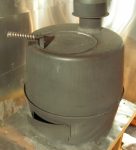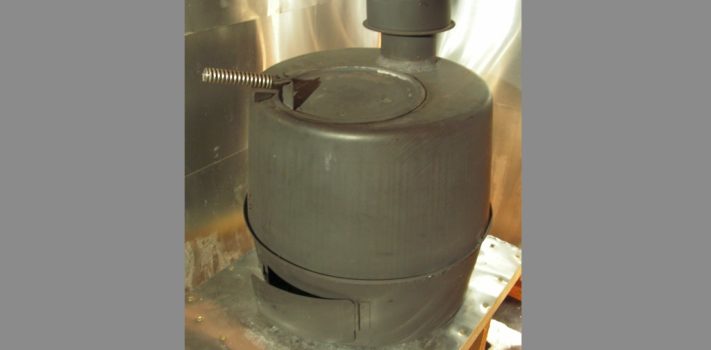In my most recent article titled Practical Wood Stoves, I discussed affordable and durable conventional wood stoves for the home in a general way. An early 1980s Forester wood stove was the focus for that class of stove. There are a plethora of wood stoves on the market. When selecting an appliance that we may very well depend upon day in and day out for the next decade to provide life-sustaining heat, we must be careful not to settle on what is on hand or what looks good in the home, and certainly not what is the most affordable. I would avoid the low-hanging fruit. I hope that you base a decision on the standards that might be better appreciated after reading that article. That is the help I wanted to provide. I want like-minded people to survive.
We should understand what we are buying and for what purpose, because given current events and potential financial and political upheaval, we may only have one chance to get it right. There are ‘good’ used wood stove that are affordable, and there are many kinds purpose-built stoves for various applications and markets. My focus in this article is on those that are the most practical and portable which offer the type of stove that fits this criteria, and does it all well.
 The U.S. Army H-45 “radiant space heater” stove that will be discussed in greater detail later in this article series is recommended by Jack Lawson, the author/editor of The Civil Defense Manual. I concur with him, with just a caveat or two. If you live where few trees grow such as the Arctic or a desert and will use diesel as fuel, the the H-45 is the better choice. If I could make a grate and remove the oil burner and convert it into a wood burner, then the H-45 is a better choice. If I had to leave everything behind including the kitchen sink, then I would take the H-45 — or the M1941 stove — with me if I was able to burn wood. We can keep our options open and can do so if we understand what we are shopping for and its strengths and weaknesses, or Pros and Cons.
The U.S. Army H-45 “radiant space heater” stove that will be discussed in greater detail later in this article series is recommended by Jack Lawson, the author/editor of The Civil Defense Manual. I concur with him, with just a caveat or two. If you live where few trees grow such as the Arctic or a desert and will use diesel as fuel, the the H-45 is the better choice. If I could make a grate and remove the oil burner and convert it into a wood burner, then the H-45 is a better choice. If I had to leave everything behind including the kitchen sink, then I would take the H-45 — or the M1941 stove — with me if I was able to burn wood. We can keep our options open and can do so if we understand what we are shopping for and its strengths and weaknesses, or Pros and Cons.
The Role of Wood Stoves in Modern America
Selecting a wood stove is a very important decision. As our society has moved away from such primitive means, it has lost touch with the issues that define what is a practical and therefore a ‘good’ wood stove in any vernacular, and in particular, what is a utilitarian wood stove that can serve us well, cook our meals, and provide life-sustaining heat. From the perspective of those who live a modern lifestyle (that are the majority of Americans), the wood stove has become mostly obsolete and a curiosity.
Liberal local and state governments have worked hard to regulate and ban the use of wood stoves in several regions pushing this essential further outside the experience of what is becoming a society that is sorely out of touch with reality. However humble the wood stove, it is the centerpiece, an adjunct necessity for survivalists that is an essential that greatly helps us to be as self-sufficient as possible, yet receives little attention and discussion.
For those in the cold north, most in the small towns and larger cities are dependent upon electricity and propane or natural gas, blissfully unaware that a wood stove an essential for those located in the cold north, those whom would isolate themselves from the madness and mayhem surely to come. Most others will unfortunately learn the hard way.
The best way to prepare for an uncertain future is to incrementally and in a balanced way obtain all of the essentials needed for a worst case scenario that one can imagine. Preparing over time is the best way, yet those new to the process of preparing will likely be burdened with the enormous expense if they did not begin to prepare but only in the last year or so.
Why Choose the M1941 OR H-45 Stove
What might pass as a good-looking brand new stove is in actually only loosely correlated with what is in reality a ‘good’ wood stove. If the manufacturing occurred in Asia, the risk that it would break in the case of cast iron, or suffer from heat erosion and failed welds from fatigue experienced by countless heating and cooling cycles is much greater. The best metal is U.S. virgin steel or cast iron that is found in vintage stoves.
I would have more confidence in a vintage or antique stove that was designed and used to sustain life in early America. Antique or vintage stoves have withstood the test of time. They were made to be used daily as their intended purpose. How a stove is designed to function is only secondary to the metal and processes of its manufacturer and its design and function. A stove would be ‘no good’ if it were prone to failure or easily broken. Please do not be lured a product that is aggressively marketed, looks good, and is inexpensive to purchase.
Do not buy a hunk of junk made of Chineseisum, regardless of how attractive it looks and how low its price is. The Chinese are masters of marketing and masters of the art of making a junky product look like a higher quality product o a larger product than it actually is. I would not risk lives by buying a cheap Chinese wood stove. No way. Pay the money or go out of the way to purchase a time-tested brand and practical design. As someone who lives well under the poverty line, I will gladly trade sweat instead of dollars to get what meets a higher standard. I do so regularly.
For the last 10 years, I have used the M1941 military tent stove to heat my small cabin. I can wholeheartedly say that it is certainly good enough and could be considered as an all-round wood stove ideal for small cabins that are not well insulated. And it is quite portable. I could take it with me if necessary. It has kept me comfortable at -30F during many winters and has been used daily for cooking and canning and made the use of propane for cooking unnecessary. A more thorough real-world account of how suitable and reliable the M1941 is to my knowledge is not available elsewhere on the Internet.
If I could only afford one wood stove that would have to be suitable for all the imaginable situations that might be involved during a societal collapse, it would be a U.S. Army M1941 stove. It would have to be affordable and be portable. I made this decision nearly 15 years ago and purchased a M1941 military tent heater and stove that has served me well. While I owned many wood stoves, none could be considered truly portable and perform as an all-around wood stove. Whoever designed this stove for the military knew what they were doing. It was used by our armed service from WW2 and into the 1980s. And 40 years or longer in the improved version, the H-45.
While my homemade portable wood stoves could fit into a backpack or sled, these are suitable for short-term survival situations only, yet not for a long-term off-grid situation. In my experience of more than 10 years with this stove, I discovered that it is one of the most versatile and practical stoves that I have used.
As I’m writing this, I am using this stove to slow-cook three chickens in a pressure cooker. That will cook the remaining meat off of the bones and cook the small bones into an excellent base for chicken soup stock. This wood stove will provide a low level of heat that sustains pressure in the pressure cooker for many hours.
This class of small and portable wood stoves could be particularly important to those who live in smaller homes, and for those looking for a portable and affordable option as a part of their contingency planning. Or, it could be used as one’s primary stove. Despite the increase in their price during the last decade they are still worth the cost. Natural disasters, or those leveraged by man-made causes will almost surely continue to occur in the future.
If not for the ability to produce heat, certainly for the cooking of food and for boiling contaminated water for drinking, the wood stove is important even in warmer climates and in all seasons and regions of the U.S.. In the Intermountain West it is not hurricanes, but forest fires that are a very real and serious threat that have forced people in a region to quickly flee. Should our homesteads be threatened and burned into the ground, we might only have what we can take with us. In this event, I would certainly leave my American Express Card at home and take the M1941 or H-45 stove with me.
In northern regions of the U.S., winter weather inevitably comes and we need those items that are essential to life. What would be the bare necessities? Those would be the essentials that American pioneers once considered essential for survival. These are today still the most important items we should be able to take with us should escaping a disaster.
Hopefully, we have a prearranged destination and pre-positioned supplies and equipment waiting for us. But a fully mobile option should also be a part of our planning. A smaller cast iron wood stove would be one such item the pioneers would have chosen, as relatively heavy as it was. Those were thrice the weight of the M1941 stove, or even more. Fortunately, we can now do better, and if this auxiliary or portable stove fits many roles, then we could standardize on that option.
(To be continued tomorrow, in Part 2.)










